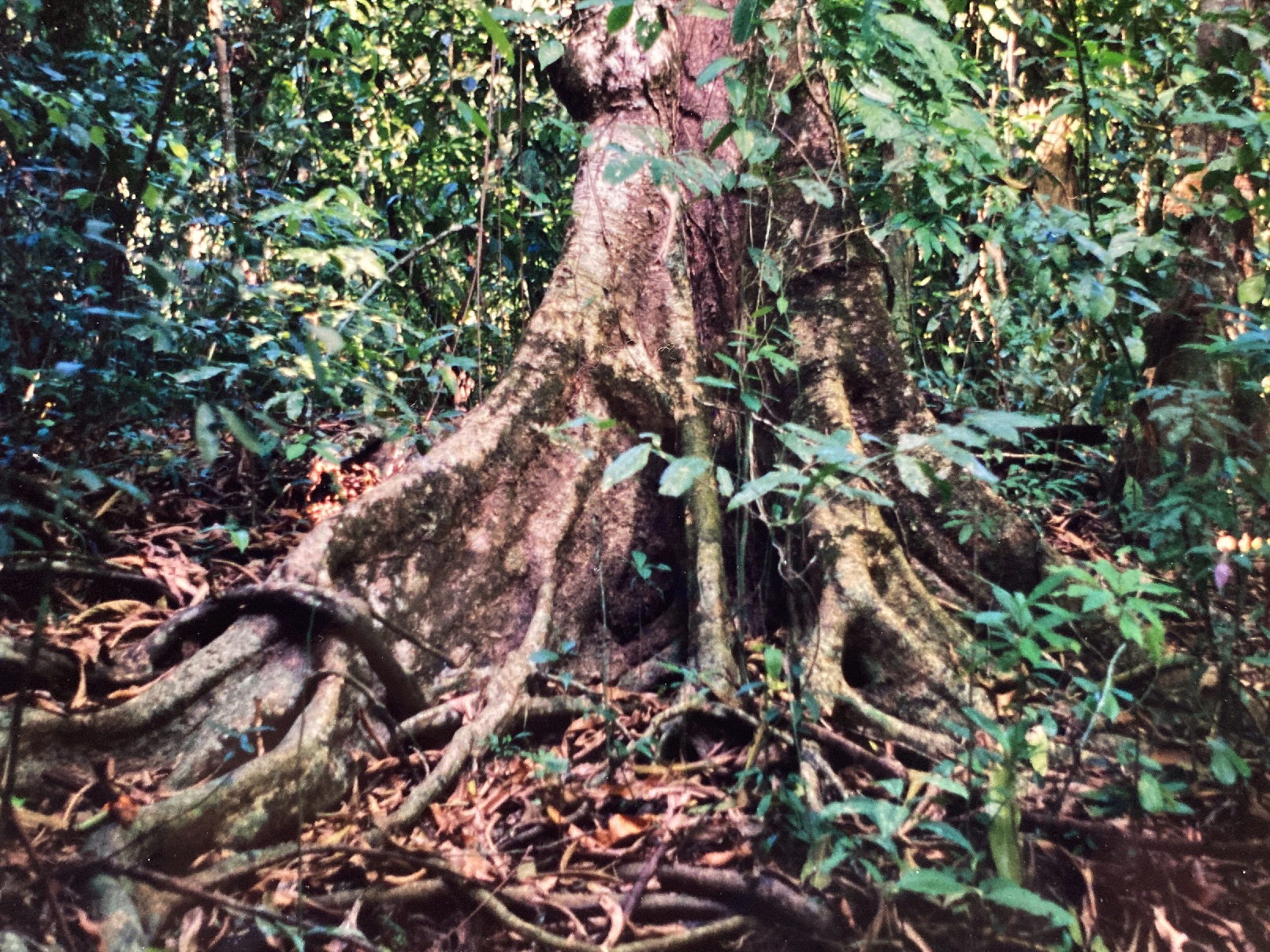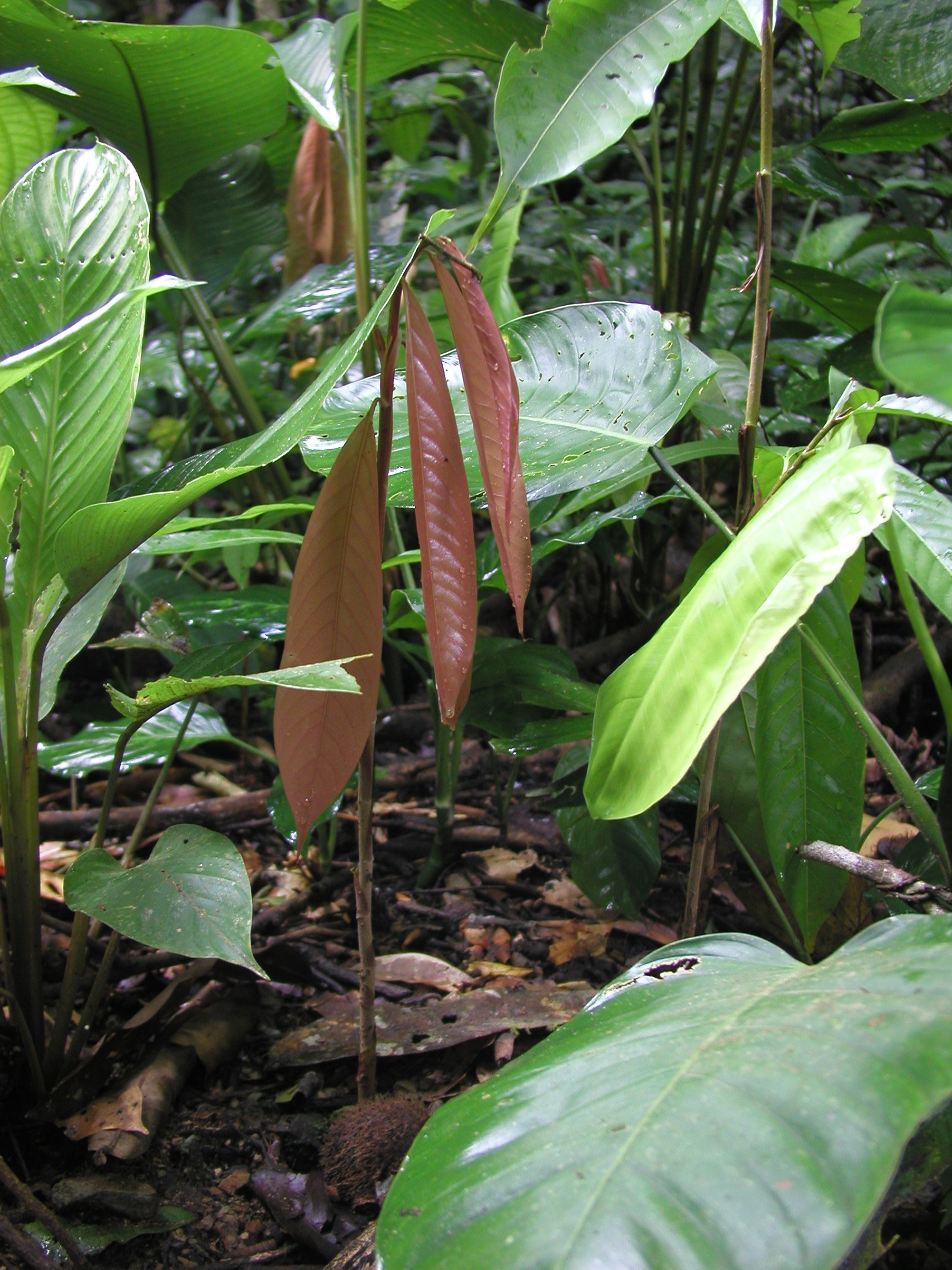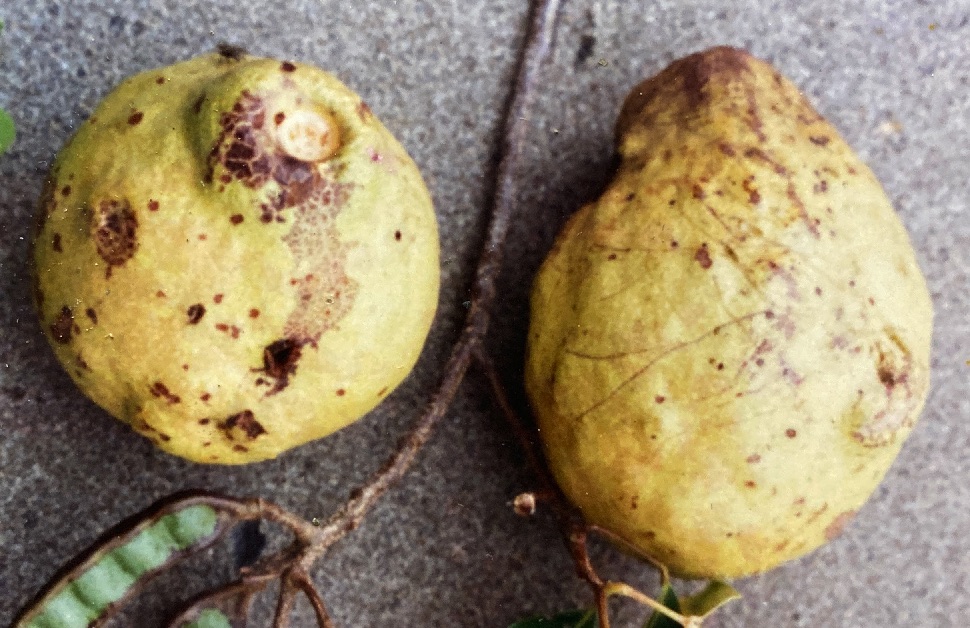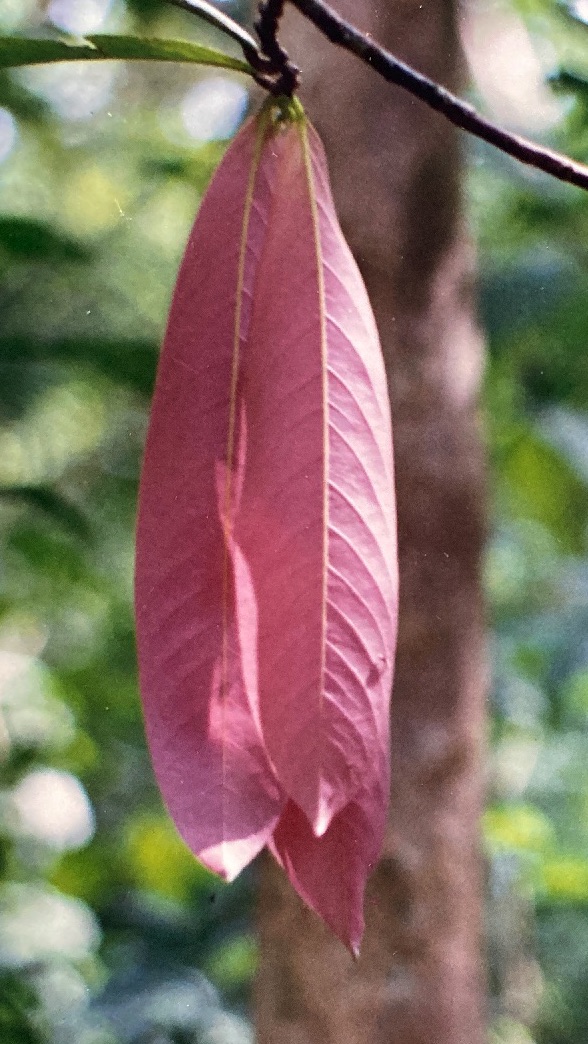Licania platypus (Hemsl.) Fritsch
Chysobalanaceae SONZAPOTE
Occasional evergreen canopy tree (25-35 m) notable for the breathtaking, iridescent pink color of its new foliage and the sweet, pumpkin-like flavor of its large, green fruits. Though more commonly limited to a height of about 25 m, individuals with more dominating stature (35 m or more) are common in the reserves of the southern Nicoya Peninsula.
Description: Small to moderately sized Sonzapote trees have straight, buttressless trunks (50 cm) of irregular cross-section. The largest boles – possessed by emergent specimens nearly one meter in diameter – may exhibit steep, fat, well-developed buttresses. The gray bark, roughly textured by thick, point lenticels, is often mottled with pastel shades of white, pink, and orange due to the presence of abundant lichens that cling to – and seem to prefer – this bole. Limbs are stout and subdivide into relatively few, thick twigs – still, thanks to Sonzapote’s very large leaves, the tall, narrow crown is dense.
Leaves are simple, alternate, long (28 by 7 cm) and finger-like, appearing in two tiers on opposite sides of the twig. Dark green, thick, and leathery, the blades curl slightly toward their midribs. They are also narrowly elliptical in shape, have rounded apices lacking drip tips, and are supported by thick petioles (2 cm).Sonzapote crowns experience varying percentages leaf loss and replacement immediately preceding and/or during the dry season, but activity of this type is most intense during December. Then, trees maintain a large number of pink, translucent, and flaccid new leaves, hanging limp and sheet-like from the twigs. (This phenomenon is often particularly pronounced in Sonzapote saplings, no more than a few meters in height).
Flowers (0.5 cm) are borne in large, pyramidal panicles (20 cm) terminally positioned along the twigs. Each blossom is composed of five, creme colored petals, an orange calyx (providing the blossom’s only real color), and fifteen longer, prominent stamens. When blossoming (during February and March) the air around Sonzapote trees is notably scented and sweet smelling. Myriad, minute, falling petals often form a constant drizzle that may eventually dust the forest floor with a tenuous layer of white flecks.
Fruits develop rapidly in the crown, attached to the tips of the thick twigs. They are large (12 cm or more), more or less spherical, lumpy, pale-green drupes. Under a thin skin, each fruit possess a 1.5 cm layer of custard-colored, edible pulp surrounding a single, extremely fibrous, avocado-sized seed. Usually, fruits fall from the trees while still hard and unripe, but soften on the ground within two or three days. Fruiting occurs in June and July. Seeds germinate within a month of harvest, and the large, 30 cm seedlings are again made conspicuous by their long, pink, limp leaves – seen dangling from their stems like flags from a flagpole on a windless day. Though harvests occur annually, individual trees follow a two year cycle in which years of prolific fruit production alternate with much leaner ones.
Similar Species: The narrow, finger-like foliage produced by the Sonzapote tree stands as a unique hallmark useful in its identification. No other species present along the Pacific slope boasts such exaggeratedly long and slim leaves. During the dry season, watch for the distinctly un-forest-like hues of the new foliage – Sonzapote trees stand out readily from their emerald green environment when it is present.
Natural History: Insects, especially bees, are the main agents of pollination in Sonzapote. The sweet fruits are a favorite food of ground-dwelling mammals like agoutis and pacas, which feed on them at night, once they have ripened.The edible layer of pulp is densely permeated by stringy fibers that are attached to the pit, making it difficult to separate the fruit from the seed. This may be an adaptation designed to coerce animals into carrying Sonzapote seeds while eating. In spite of this, most seeds are generally not dispersed any great distance, germinating below or very near the parent tree. Newly expanded Sonzapote foliage, perhaps more striking than that of any other forest plant, is nevertheless not unique in its coloration. Other trees, including many palms, produce new leaves that initially lack chlorophyll – the dominant green pigment that masks all others that are present. At such times, the colors of other plant chemicals are visible and leaf hues may vary anywhere from white to bronze to pink. This practice may be a behavioral adaptation intended to help rainforest trees conserve nutrients (in an environment where soil minerals are notoriously scarce, thanks to high rates of weathering and leeching caused by torrential and warm tropical rains).Newly expanded, soft foliage is especially appealing and vulnerable to insect predators. Rather than risk losing nutrient-rich chlorophyll by including it in these new leaves, the plant delays the fabrication of this chemical until the foliage is mature – thick, stiff and less palatable to herbivores. It is also possible that these pastel colors reflect the presence of insect-deterring chemicals, appropriately stored in the leaves at this crucial time.
Uses: Sonzapote’s most valuable product is its edible fruit. Once ripe, the outer layer of pulp is sweet, with a pumpkin-pie-filling-like texture and flavor. Unfortunately, heavy parasitism of the large seed – evidenced by bore-holes through the fruit and into its core – as well as the omnipresent fibers – do detract from the fruit’s appeal.
Distribution: Sonzapote is found scattered thinly throughout the primary forest, thriving in all edaphic regimes. The species is native to the lowlands of both Costa Rican slopes and it ranges from southern Mexico to Colombia.
Photos: Tree Trunk Bark Leaf Leaf2 Sapling Flower Flower2 Flower3 Fruit





